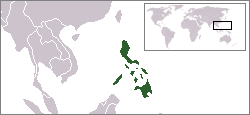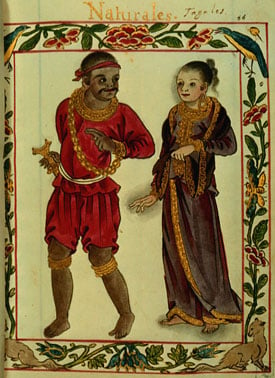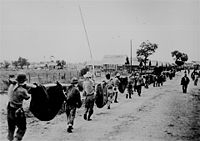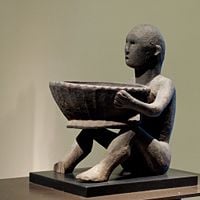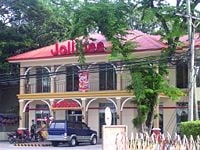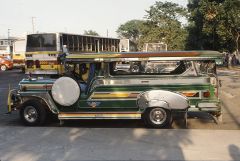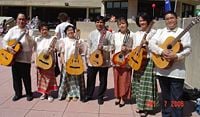Difference between revisions of "Philippines" - New World Encyclopedia
Mike Butler (talk | contribs) m |
Mike Butler (talk | contribs) |
||
| Line 75: | Line 75: | ||
The country was named ''"Las Islas Filipinas"'' (The Philippine Islands) by [[Ruy López de Villalobos]] after King Philip II of Spain. | The country was named ''"Las Islas Filipinas"'' (The Philippine Islands) by [[Ruy López de Villalobos]] after King Philip II of Spain. | ||
| − | Philippine culture has many affinities with the [[Western world|West]]. Roman | + | Philippine culture has many affinities with the [[Western world|West]]. The Philippines is one of only two Roman Catholic countries in Asia, the other being [[East Timor]]. English and Filipino are the official languages. |
| + | |||
| + | An estimated 1 million Filipinos were killed fighting the Japanese during the Second World War. Successive administrations stretching since the overthrow of dictator Ferdinand Marcos in 1986 have faced allegations of corruption and election rigging. | ||
==Geography== | ==Geography== | ||
| Line 280: | Line 282: | ||
==External links== | ==External links== | ||
| − | |||
* [http://www.gov.ph Philippine Government Official website] ''The Official Website of the Republic of the Philippines'', observed February 14, 2007. | * [http://www.gov.ph Philippine Government Official website] ''The Official Website of the Republic of the Philippines'', observed February 14, 2007. | ||
| Line 290: | Line 291: | ||
* [https://www.cia.gov/cia/publications/factbook/geos/rp.html Philippines] The World Factbook, 2007, observed February 14, 2007. | * [https://www.cia.gov/cia/publications/factbook/geos/rp.html Philippines] The World Factbook, 2007, observed February 14, 2007. | ||
| − | * [http://www.everyculture.com/No-Sa/The-Philippines.html The Philippines] Countries and Their Cultures, observed February 13, 2007. | + | * [http://www.everyculture.com/No-Sa/The-Philippines.html The Philippines] Countries and Their Cultures::No-Sa, observed February 13, 2007. |
| + | |||
| + | * Ronald E. Dolan, ed., 1991 [http://countrystudies.us/philippines/''Philippines: A Country Study''] Library of Congress, observed February 14, 2007. | ||
| − | * | + | * Blair, Emma Helen, 1911, [http://www.gutenberg.org/browse/authors/b#a2296 ''History of the Philippine Islands'']Project Gutenberg, observed February 14, 2007. |
| − | |||
| − | |||
{{credit|104634521}} | {{credit|104634521}} | ||
Revision as of 07:46, 14 February 2007
| Republika ng Pilipinas Republic of the Philippines | |||||
| |||||
| Motto: Maka-Diyos, Makatao, Makakalikasan, at Makabansa (English: "For God, People, Nature, and Country") | |||||
| Anthem: Lupang Hinirang ("Chosen Land") | |||||
| Capital | Manila 14°35′N 121°0′E | ||||
|---|---|---|---|---|---|
| Largest city | Quezon City | ||||
| Official languages | Filipino and English | ||||
| Government | Unitary presidential republic | ||||
| - President | Gloria Macapagal Arroyo | ||||
| - Vice President | Noli de Castro | ||||
| Independence | from Spain and the U.S. | ||||
| - Declared | June 12 1898 | ||||
| - Self-government | March 24 1934 | ||||
| - Recognized | July 4 1946 | ||||
| - Current constitution | February 2 1987 | ||||
| Area | |||||
| - Total | 300,000 km² (72nd) 115,831 sq mi | ||||
| - Water (%) | 0.6 | ||||
| Population | |||||
| - 2005 estimate | 90,420,000 | ||||
| - 2000 census | 76,504,077 | ||||
| - Density | 276/km² 715/sq mi | ||||
| GDP (PPP) | 2005 estimate | ||||
| - Total | $453 billion | ||||
| - Per capita | $4,923 | ||||
| GDP (nominal) | 2005 estimate | ||||
| - Total | $98,731 billion | ||||
| - Per capita | $1,168 | ||||
| HDI (2006) | 0.763 (medium) | ||||
| Currency | Philippine peso (piso) (PHP)
| ||||
| Time zone | PST (UTC+8) | ||||
| Internet TLD | .ph | ||||
| Calling code | +63 | ||||
| * Cebuano, Ilokano, Hiligaynon, Bikol, Waray-Waray, Kapampangan, Pangasinan, Kinaray-a, Maranao, Maguindanao, Tagalog, Tausug are the auxiliary official languages in their respective regions. Spanish and Arabic are promoted on an optional and voluntary basis. | |||||
The Philippines, officially the Republic of the Philippines (Republika ng Pilipinas; RP), is an island nation located in the Malay Archipelago in Southeast Asia.
The country was named "Las Islas Filipinas" (The Philippine Islands) by Ruy López de Villalobos after King Philip II of Spain.
Philippine culture has many affinities with the West. The Philippines is one of only two Roman Catholic countries in Asia, the other being East Timor. English and Filipino are the official languages.
An estimated 1 million Filipinos were killed fighting the Japanese during the Second World War. Successive administrations stretching since the overthrow of dictator Ferdinand Marcos in 1986 have faced allegations of corruption and election rigging.
Geography
The Philippines constitutes an archipelago of 7107 islands with a total land area of approximately 116,000square miles (300,000 square kilometres), making it 72nd largest country by area, or slightly larger than the United States state of Arizona.
It borders the Philippine Sea on the east, on the South China Sea the west, and the Celebes Sea on the south. The island of Borneo lies a few hundred miles southwest and Taiwan directly north. The Moluccas and Sulawesi are to the south, and Palau is to the east beyond the Philippine Sea.
The local climate is hot, humid, and tropical. The average yearly temperature is around 79.7°F (26.5°C). There are three seasons: The hot season lasts from March to May, the rainy season from June to November, and the cold season from December to February. The southwest monsoon (May-October) is known as the "habagat" and the dry winds of the northeast monsoon (November-April) as the "amihan". The country itself is undergoing desertification in Sorsogon, Baguio, Davao and the Sierra Madre mountain range.
Most of the mountainous islands used to be covered in tropical rainforest and are volcanic in origin. The highest point is Mount Apo on Mindanao at 9692 feet (2954 metres). There are many active volcanos such as Mayon Volcano, Mount Pinatubo, and Taal Volcano. The country lies within the typhoon belt of the Western Pacific and about 19 typhoons strike per year.
Lying on the north-western fringes of the Pacific Ring of Fire, the Philippines sustains frequent seismic and volcanic activities. Some 20 earthquakes are registered daily, though most are too weak to be felt. The last great earthquake was the 1990 Luzon earthquake.
Environmental issues include uncontrolled deforestation especially in watershed areas, soil erosion, air and water pollution in major urban centers, coral reef degradation, increasing pollution of coastal mangrove swamps that are important fish-breeding grounds
The Cagayan River of northern Luzon is the longest river. The nearly circular Manila Bay, is connected to the Laguna de Bay by means of the Pasig River. Subic Bay, the Davao Gulf and the Moro Gulf are some of the important bays. Transversing the San Juanico Strait is the San Juanico Bridge, that connects the islands of Samar and Leyte.
The busy port of Manila, on the country’s largest island of Luzon, is the capital. With 1.5-million inhabitants, it is the second largest city after nearby Quezon City. Manila is the hub of a thriving metropolitan area that is home to over 10 million people.
History
Archeological and paleontological evidence suggests that Homo sapiens existed in the large island province of Palawan about 50,000 B.C.E. The indigenous Aeta people, who live in scattered, isolated mountainous areas, are thought to have arrived around 30,000 B.C.E., across land bridges, possibly from China or the Andaman Islands. The oldest human fossil found in the Philippines is the 22,000-year-old skull cap of a "Stone-Age Filipino" discovered inside Tabon Cave, Palawan, on May 28, 1962, and dubbed the "Tabon Man".
The ancestors of the vast majority of the Filipino people, the Austronesians from Taiwan, settled in northern Luzon around 2500 B.C.E. They spread through the Philippines and later colonized most of maritime Southeast Asia and the Western Pacific Islands.
The basic unit of settlement was the barangay, headed by a datu (chief). Within the barangay, there were maharlika (nobles), timawa (freemen), and dependents, which included landless agricultural workers; and alipin (slaves), who were mostly war captives.
Muslim, Chinese and Indian traders made contact with the Philippines during the course of the next thousand years. Traders and proselytizers from the Indonesian islands brought Islam, which by the sixteenth century, was established in the Sulu Archipelago, spread to Mindanao, and reached the Manila area by 1565. Animism remained the religion of the majority of the Philippine islands. In some areas, Muslim immigrants set up territorial states ruled by rajas or sultans who exercised sovereignty over the datu.
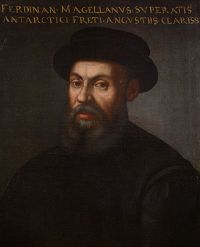
Sailing for the Spanish, the Portuguese explorer Ferdinand Magellan and his crew were the first Europeans to arrive in the archipelago in 1521. Magellan was killed by indigenous warriors in Mactan Island. Miguel López de Legazpi arrived in 1565 and formed the first Spanish settlements, and paved the way for colonization. Roman Catholic missionaries converted most of the inhabitants.
In the next 333 years, the Spanish military fought off local indigenous revolts and external challenges from the British, Chinese, Dutch, French, Japanese, and Portuguese. The most significant loss for Spain was the temporary occupation of the capital, Manila, by the British during the Seven Years' War. The Philippines was governed from Mexico from 1565 to 1821, before it was administered directly from Spain. The Manila Galleon travelled once or twice a year to Acapulco, Mexico,beginning in the late sixteenth century. The Philippines opened itself to world trade on September 6, 1834.
Demands for greater representation in Spain escalated into a revolution, started in 1896 by the Katipunan, led by Andrés Bonifacio. Emilio Aguinaldo established a revolutionary government. Revolutionary leader José Rizal was executed for treason on December 30, 1896. The Spanish-American War, which began in Cuba in 1898, soon reached the Philippines when Commodore George Dewey defeated the Spanish squadron at Manila Bay. Aguinaldo declared the independence of the Philippines on June 12, 1898, and was proclaimed head of state. Spain ceded the Philippines, together with Cuba, Guam and Puerto Rico to the United States. By 1899, the United States was at war with Philippine revolutionaries. The US proclaimed the war over when Aguinaldo was captured by American troops on March 23, 1901, but the struggle continued until 1913.
The country's status as a colony changed when it became the Commonwealth of the Philippines in 1935, which provided for more self-governance.
Japan launched a surprise attack on the Philippines on December 8, 1941, just 10 hours after the attack on Pearl Harbor. The Philippine defense continued until the final surrender of United States-Philippine forces on the Bataan Peninsula in April 1942 and on Corregidor in May. Most of the 80,000 prisoners of war captured by the Japanese at Bataan were forced on the infamous Bataan Death March to a prison camp 65 miles (105 kilometers) to the north. It is estimated that about 10,000 Filipinos and 1200 Americans died before reaching the camp. The Japanese occupation was opposed by large-scale underground and guerrilla activity.
U.S. General Douglas MacArthur's Allied forces landed on Leyte on October 20, 1944. Landings in other parts of the country followed, and the Allies pushed toward Manila. Fighting continued until Japan's formal surrender on September 2, 1945. An estimated 1 million Filipinos had been killed, and Manila was extensively damaged.
World War II had left the Philippines demoralized and severely damaged. Elections held in April 1946, resulted in Manuel Roxas becoming the first president. The Philippines achieved independence from the United States on July 4, 1946. The task of reconstruction was complicated by the activities of the Communist-supported Hukbalahap guerrillas (known as "Huks"), who had evolved into a violent resistance force against the new Philippine government. Roxas suddenly died in office in 1948. The Huk movement had waned in the early 1950s, finally ending with the unconditional surrender of Huk leader Luis Taruc in May 1954.
After a series of presidents, Ferdinand Marcos was elected president in 1965. He initiated ambitious public works projects and intensified tax collection, which brought prosperity throughout the 1970s. With massive loans and economic aid from the United States, his administration built more roads than all his predecessors combined, and more schools than any previous administration. Barred from seeking a third term, Marcos declared martial law on September 21, 1972, and ruled the country by decree. His authoritarian rule became marred with pervasive corruption, and cronyism.
Pressure against the Marcos regime came to a head when Opposition leader Benigno Aquino, Jr.returned from exile and was assassinated on August 21, 1983. Under pressure from the United States, and after large protests, Marcos allowed for a presidential election. The election, held on February 7, 1986, was believed to be fraudulent, and resulted in a heavily disputed outcome and a stand-off between military mutineers and the military loyalists. Protesters supported the mutineers. Prominent cabinet officials resigned.
A radio call for mass protest on February 22, 1986, sparked the EDSA Revolution, also known as the People Power Revolution of 1986. Four days of peaceful action by millions of Filipinos in Manila led to the downfall of the Marcos regime and the installation of Corazon Aquino as president. EDSA stands for Epifanio de los Santos Avenue, a main highway in Manila and the main site of the demonstrations.
Massive national debt, government corruption, coup attempts, a communist insurgency, and a Muslim separatist movement has hampered the return of democracy and government reforms after the events of 1986. The economy improved during the administration of Fidel V. Ramos, who was elected in 1992. However, the economic improvements were negated at the onset of the East Asian financial crisis in 1997.
A 2001 EDSA Revolution led to the downfall of president Joseph Estrada. Thousands of citizens converged at the EDSA Shrine to protest against President Joseph Estrada, following his aborted impeachment trial at the Senate of the Philippines. Estrada was a former movie actor who was popular with the masses, but was reviled by the upper and elite classes for his alleged corruption.
The administration of president Gloria Macapagal-Arroyo, since 2001, has been hounded by allegations of corruption and election rigging.
Politics and government
The government of the Philippines is organized as a presidential unitary republic, where the president functions as head of state, the head of government, and the commander-in-chief of the armed forces. The president is elected by popular vote to a six-year term, during which he or she appoints and presides over the cabinet of secretaries.
The bicameral Congress comprises the Senate and the House of Representatives. Members of the Senate are elected at large, and those of the House of Representatives by geographical district. The 24 senators serve six-year terms, with half retiring every three years, while the House of Representatives comprises 250 members serving three-year terms.
The Supreme Court heads the judicial branch of government, with a chief justice as its head and 14 associate justices, all appointed by the president from nominations submitted by the Judicial and Bar Council. Other courts include the Court of Appeals, the Regional Trial Courts, and the Metropolitan Trial Courts.
The political parties in the Philippines are of diverse ideologies and are plentiful in number. The Philippines has a multi-party system with numerous parties in which no one party often has a chance of gaining power alone, and parties must work with each other to form coalition governments.
Philippine political parties are unique. Normally, political parties are created to represent various interest groups. Philippine political parties were created by American tutelage, comprising proteges of elite families educated at American Universities. Academic degrees masked the incompetence of this educated elite who had become alienated from Philippines society, and who tended to represent their clans' interest. The result was a legislature that is an arena not for public dialogue but as an elite clique engaged in profiteering and political showmanship.
President Gloria Macapagal-Arroyo sought to amend the constitution to a unicameral parliament under a federal setting similar to what they believe to be the German constitution. The country would be split into "states" with each one having a local legislature responsible for certain functions. Included in the amendments are plans to ease a ban on foreign ownership of property, land, and commercial organizations.
The Philippines is a founding and active member of the United Nations and is a founding member of the Association of Southeast Asian Nations (ASEAN). The Philippines is also a member of the East Asia Summit (EAS), an active player in the Asia-Pacific Economic Cooperation (APEC), the Latin Union, and a member of the Group of 24. The country is a major non-NATO ally of the U.S. but also a member of the Non-Aligned Movement.
The Philippines, along with the nation of Malta, is one of only two nations in the world where all civil marriages are for life, because civil divorce (for violations coming after the marriage) is banned, although annulment (for violations before the marriage, although it may manifest itself after the solemnization) is permitted.
The Philippines was in a dispute (in 2007) with Taiwan, China, Vietnam, and Malaysia over the oil and natural gas-rich Spratly Islands and Scarborough Shoal, and with Malaysia over Sabah. The Sultan of Sulu, who received Sabah as a gift in 1703 having helped the Sultan of Brunei defeat a rebellion, has given the Philippine government power to reclaim its lost territory. The Sultan of Sulu's family continues to receive "rental" payments for Sabah from the Malaysian government.
The Philippines is divided into three geographical areas: Luzon, Visayas, and Mindanao. It has 17 regions, 81 provinces, 117 cities, 1501 municipalities, and 41,982 barangays. Most government offices establish regional offices to serve the constituent provinces. The regions themselves do not possess a separate local government, with the exception of the autonomous region in Muslim Mindanao.
In 2006, Arroyo announced a proposal to create five economic super regions to concentrate on the economic strengths in a specific area.
The United States is one of the Philippines’ closest economic and political allies. The two countries are partners in counter-terrorism, as they both share intelligence. The two countries conduct military exercises in Mindanao, and are both heavily involved in trade and commerce.
Organized under the supervision of General Douglas MacArthur, the Armed Forces of the Philippines are loosely based on the structure of the military of the United States. While modest in its material and technological capability, the Philippines soldiers are considered one of the most battle-hardened armies in the world due to their long exposure to counter-insurgency and anti-secessionist campaigns. Consisting of army, navy and air force, due to its close relationship with the United States military, the armed forces was considered the strongest national defense program in Asia — especially in the 1950s and 1960s.
Economy
The Philippines is a developing country with an agricultural base, light industry, and service-sector economy. The Philippines has one of the busiest call-center industries in Asia, generating thousands of jobs. Agriculture, forestry, and fishing are the occupations of 40 percent of the 30 million people who are employed. People work seven days a week and take additional jobs to maintain or improve their lifestyle or pay for a child's education.
The Philippines was less severely affected by the Asian financial crisis of 1998 than its neighbors, aided in part by its high level of annual remittances from overseas workers, and no sustained run-up in asset prices or foreign borrowing prior to the crisis. From a 0.6 percent decline in 1998, GDP expanded by 2.4 percent in 1999, and 4.4 percent in 2000, but slowed to 3.2 percent in 2001 in the context of a global economic slowdown, an export slump, and political and security concerns. GDP growth accelerated to about 5 percent between 2002 and 2006 reflecting the continued resilience of the service sector, and improved exports and agricultural output.
A higher, sustained growth path is required to make progress in the alleviation of poverty given the Philippines' high annual population growth rate and unequal distribution of income. The Philippines also faces higher oil prices, higher interest rates on its dollar borrowings, and higher inflation. Fiscal constraints limit Manila's ability to finance infrastructure and social spending.
The Philippines' consistently large budget deficit has produced a high debt level, and this situation has forced Manila to spend a large portion of the national government budget on debt service. Large unprofitable public enterprises, especially in the energy sector, contribute to the government's debt because of slow progress on privatization. Credit rating agencies have at times expressed concern about the Philippines' ability to service the debt, though central bank reserves appear adequate and large remittance inflows appear stable. The implementation of the expanded Value Added Tax (VAT) in November 2005 boosted confidence in the government's fiscal capacity and helped to strengthen the peso, making it East Asia's best performing currency in 2005-06.
The Philippines is a member of the Asian Development Bank, World Bank, International Monetary Fund, and other international economic associations, such as the Asia Pacific Economic Cooperation (APEC), the World Trade Organization (WTO), the Colombo Plan, and the G-77.
The Philippines is a significant source of migrant workers; as of 2004, the Philippine government has estimated that there are over eight million overseas Filipinos, who sent home a record $10.7-billion in 2005.
Exports totalled $38.728-billion in 2004. Export commodities included electronic equipment, machinery and transport equipment, garments, coconut products, and chemicals. Export partners were the United States, 20.1 percent, Japan 15.9 percent, Hong Kong 8.5 percent, Netherlands 8.1 percent, Taiwan 6.9 percent, Malaysia 6.8 percent, Singapore 6.7 percent, and China 5.9 percent.
Import totalled $45.109-billion in 2004. Import commodities included raw materials and intermediate goods, capital goods, consumer goods, and fuels. Import partner were Japan 20.4 percent, the United States 19.8 percent, Singapore 6.8 percent, South Korea 6.4 percent, Taiwan 5 percent, China 4.8 percent, and Hong Kong 4.3 percent.
Per capita GDP was $4923 in 2005, with a rank of 102 on a list of 181 countries.
Income inequality remains persistent; about 30 million people lived on less than $2 per day in 2005. China and India have emerged as economic competitors, siphoning away investors who would otherwise have invested in the Philippines, particularly telecom companies. Regional development is also somewhat uneven, with the main island Luzon and Metro Manila gaining most of the new economic growth at the expense of the other regions.
Demographics
The Philippines is the world's 12th most populous country, with a population of over 90 million as of 2005. Roughly two-thirds reside on the island of Luzon. Manila, the capital, is the eleventh most populous metropolitan area in the world.
Life expectancy is 69.91 years. Population growth per year is about 1.92 percent, with 26.3 births per 1000 people. In the 100 years since the 1903 Census, the population has grown by a factor of eleven. This represents a much faster rate of growth than other countries in the region (Indonesia has grown fivefold over the same period).
The people of the Philippines are called Filipinos. Most Filipinos are descended from the various Austronesian-speaking migrants who arrived in successive waves over a thousand years ago from Taiwan, genetically most closely related to the Ami tribe. These ethnic Filipinos are divided into various ethnolinguistic groups, the three most numerous being the Bisaya, the Tagalogs, and the Ilocanos. The Negritos or Aetas, who are considered as the aboriginal inhabitants of the Philippines, currently number fewer than 30,000 people (0.03 percent).
Filipinos of Chinese descent, who had been settling in the Philippines since pre-Hispanic times, currently forms the largest non-Austronesian ethnic group, claiming about two percent of the population. Other significant minorities, ranked according to population, include Americans, Japanese, British, Australians, Europeans (particularly Spanish and Basques), Koreans, and South Asians. There are also numerous Arabs and Indonesians in the country, especially in Mindanao. The Philippines has Asia's largest American population.
Throughout the country's history, various ethnic groups as well as the migrants and colonizers have intermarried, producing Filipino Mestizos. According to genetic studies, about 3.65 percent of the Filipino population are partly of Caucasian ancestry (mostly of Spanish, English-American and other European people descent), and about 10 percent have some Chinese ancestry.
More than 170 languages are spoken in the country, almost all of them belonging to the Western Malayo-Polynesian language group of the Austronesian language family. According to the 1987 Constitution, Filipino, heavily based on Tagalog, and English are both the official languages. The 12 major regional languages are the auxiliary official languages of their respective regions, each with over one million speakers: Tagalog, Cebuano, Ilocano, Hiligaynon, Waray-Waray, Bikol, Kapampangan, Pangasinan, Kinaray-a, Maranao, Maguindanao and Tausug. English is used by some Filipinos as their first language, particularly those belonging to the upper echelons of society.
The Lan-nang-oe variant of Min Nan is widely spoken by the country's Chinese minority
Spanish was the original official language of the country for more than three centuries, but was used mainly by the educated illustrados (including José Rizal) or self-taught natives and the Spanish authorities. Spanish was the language of Philippine Revolution, and the 1899 Malolos Constitution proclaimed it as the official language. Following the American occupation of the Philippines, its use declined, especially after 1940. Currently, only a few Spanish Mestizo families speak it as their first language, though many others use it together with Tagalog and English.
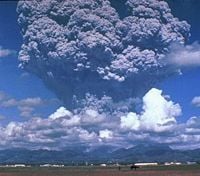
The use of Arabic is prevalent among the Filipino Muslims, and is taught in madrasah (Muslim) schools.
The Philippines is one of only two Roman Catholic countries in Asia, the other being East Timor. About 90 percent of Filipinos are Christian, where 81 percent belong to the Roman Catholic Church, and the nine percent composed of Protestant denominations, the Philippine Independent Church, and Iglesia ni Cristo. While Christianity is a force in the culture, indigenous traditions and rituals still influence religious practice.
The term “animism” can be used to describe the indigenous spiritual traditions practiced during pre-colonial times. A handful of the indigenous tribes continue to practice it. It is a collection of beliefs and practices anchored in the idea that the world is inhabited by spirits and supernatural entities, both good and bad, and that respect be accorded to them through nature worship.
Approximately five percent of Filipinos are Sunni Muslim. They primarily settle in parts of Mindanao and the Sulu archipelago. Most lowland Muslim Filipinos practice normative Islam, although the practices of some Mindanao's hill tribe Muslims reflect a fusion with animism.
There are also small populations of Buddhists, Jews and animists, which, along with other non-Christians and non-Muslims, collectively comprise five percent of the population.
Nineteen percent of the land is arable and 46 percent consists of forests and woodlands. Large amounts of arable land remain in the hand of absentee landowners given land grants during the Spanish colonial period. Peasant groups such as the HUKs (People's Liberation Army in the 1950s, and the NPA (New People's Army) in 2007 have resorted to guerrilla tactics to obtain land for the poor.
Marriage includes a civil ceremony conducted in city offices, and a religious ceremony. A feature is the presence of sponsors, friends and relatives who attest to the popularity and potential success of a couple, and contribute towards wedding costs. There are no arranged marriages. Men are expected to marry. Young professionals wait until their late 20s to marry, and engagements of five to seven years, during which time the couple becomes established financially, are not uncommon. Divorce is illegal, but annulment is available. Interfaith marriages are rare.
The extended family is the basic unit of Philippines society. A woman's closest friends come from within the family. Mothers and daughters who share a home make decisions concerning the home without conferring with male family members. One child is expected to remain at home to care for the parents and grandparents. The home may include children from the extended family, and single aunts and uncles. Several houses may be erected on the same lot. Childcare is shared. Fathers carry and play with children but are unlikely to change diapers. Grandparents who live in the home are the primary care givers since both parents work. Needy relatives live in and provide household and childcare help. Young people may work their way through college by exchanging work for room and board. Nieces and nephews are referred to as one's own children and cousins are referred to as sisters and brothers. Unmarried adult women may legally adopt a sibling's child.
Inheritance laws provide that all children acknowledged by a father, whether born in or out of wedlock, share equally in the estate. Females share equally with males. Anyone remotely related is known as a cousin. Indigenous tribes live in clan groups. People have a strong sense of belonging to a place. New Year's Day, Easter, and All Saint's Day are the most important family holidays.
Filipinos value social acceptance and see education as a way to provide upward mobility. Color of skin, beauty, and money help determine a person's social position — a light-skinned attractive person will advance before his or her colleagues. Family position and patron-client relationships are part of achieving success. Government officials, wealthy friends, and community leaders sponsor hundreds of weddings and baptisms each year. About two percent of the population is wealthy. The masses live in poverty, while the middle class feels too obligated to those in power to push for any change.
Money to buy consumer goods indicates power. Wealthy people lead western lifestyles. Owning a vehicle is a statement of a high social level, as do the style of houses and furnishings. Women above the poverty line have extensive wardrobes. Sending children to the best schools indicates social position.
Culture
The Spanish colonization of the Philippines, governed from Mexico, lasted for more than 350 years, thus there is a significant presence of Spanish and Mexican influence in many facets of the Filipino culture. The Filipino language, more commonly known as Tagalog, contains many borrowed Spanish words. Large Spanish brick churches built during the colonial era dominate the towns. Countless streets, towns and provinces have Spanish names. Spanish surnames prevail. This came as a result of a colonial decree for the systematic distribution of family names and implementation of the Spanish naming system. A Spanish surname therefore does not necessarily denote Spanish ancestry.
The use of English language in the Philippines is America's visible legacy. The most commonly played sport in the Philippines is basketball. There is also a wide "imitation" of American cultural trends, such as the love of fast-food. Aside from the American commercial giants such as McDonald's, Pizza Hut, Burger King, and KFC, local fast-food chains have also sprung up, including Goldilocks Bakeshop, Jollibee, Greenwich Pizza, and Chowking. Modern day Filipinos also listen to contemporary American music and watch American movies.
Most of the present celebrated religious traditions are a mix of Christian, pagan and other local religious rites. Each year, towns from around the country hold festivities known as Fiesta which commemorate the patron saints of each town, villages or regional districts. The festival season is celebrated with church ceremonies, street parades in honor of the patron saints, fireworks, beauty and dance contests for generations of old and new, and in some areas there are cockfighting tournaments. These Fiestas are observed in countries that had a Spanish occupational past. The Islamic southern island celebrates Muslim customs and traditions.
Native moral codes, respect of family, veneration of elders, and friendliness, all remain intact. Filipinos honor national heroes whose works and deeds contributed to the shaping of the Filipino nation. José Riza] is the most celebrated ilustrado, a Spanish-speaking reformist visionary whose writings contributed greatly in nurturing a sense of national identity and awareness. His novels |Noli Me Tangere and El Filibusterismo originally written in Spanish, are required readings for Filipino students, and provide vignettes of colonial life under the Spanish rule.
Plain steamed rice is the basis of the diet. Salt water and freshwater of fish and shellfish are eaten daily, served either fresh or salted. Fish, chicken and pork are usually fried. Garlic is added to food because it is considered healthy. Filipino food is not spicy, and is cooked on gas burners or over wood or charcoal fires and is allowed to get cold before it is eaten — from a spoon. It is also common to use the traditional method of placing food on a banana leaf and eating with one's hands. Breakfast, served at 6am, consists of food left over from the night before, and is not reheated. The widespread use of noodles, known locally as mami, are a testament of the Chinese cuisine.
Filipinos are fond of sweet foods. Coca-Cola is popular. Fatty pork is a favorite. Portions of small cubes of browned pork fat are considered a special dish. Fruits are abundant all year. Red and green bananas are eaten. Mangoes, the national fruit, are sweet and juicy. Fast food has become part of the culture, with national and international chains in many towns. Léchon, a suckling pig that has been roasted until the skin forms a hard brown crust, is served at important occasions. Gin and beer are available for men and are accompanied by balut, a duck egg with an embryo. Dog meat is a delicacy, although it is now illegal to sell it because cases of rabies have occurred. The education system is similar to that in the United States Filipino children enter public school at about age four, starting from nursery up to kindergarten. At about seven years of age, children enter a primary school (six plus one years) where the core subjects include mathematics, English, and Makabayan (a mixture of social studies and Filipino). This is followed by secondary school (four years). Students then sit for the College Entrance Examinations (CEE), after which they enter collegiate school (three plus two). The teaching medium in most local schools is English. All primary-level students graduate with a knowledge of two or three languages. Other types of schools do exist, such as private schools, preparatory schools, international schools, and science high school]]s. The Chinese, British, Americans, and the Japanese have their own schools, while there are Islamic schools in the autonomous region in Muslim Mindanao. The literacy rate was 92.5 percent in 2003 and about equal for males and females.
Filipino music is a mixture of European, American and indigenous sounds. Much of the music of the Philippines has been influenced by the 377-year-long colonial legacies of Spain. Spanish and Mexican colonizers introduced the guitar and other instruments, as well as zarzuela (a form of operetta), guitar-accompanied harana courtship music, and rondalla music, played on an ensemble of plectrum instruments.
Traditional Filipino music typically employs a combination of musical instruments belonging to the percussion, wind, and string families, usually made of bronze, wood, or bamboo. A highly sophisticated musical repertoire called kulintang exists, on Mindanao and the Sulu Archipelago, in which the main instruments used are bossed gongs not dissimilar to gongs used in Indonesia.
The United States introduced American blues, folk, R&B and rock and roll. This American influence taught the Filipinos how to create and market their own performers, and led to the emergence of superstars such as Sharon Cuneta, Gary Valenciano, Lea Salonga and Regine Velasquez, as well as the Pinay girl group phenomenon which brought Kikay, Sex bomb, Viva Hot Babes, Jaboom Twins and others.
The most notable achievement in Filipino rock of the 1960s was the hit song "Killer Joe," which propelled the group "Rocky Fellers" to #16 on the American radio charts.
In the early 1970s, Tagalog and English lyrics were both used, as in Sharon Cuneta's first hit, "Mr DJ."
Basketball courts are found in every barangay and school. Filipinos enjoy watching American professional basketball and teams in Filipino professional leagues. Cockfights are popular. Cocks, with metal spurs attached to the leg, fight until one of the cocks is unable to continue fighting or runs away. Mah-jongg, a Chinese game played with tiles, is very popular, especially with women. Boxing, badminton and billiards are popular.
ReferencesISBN links support NWE through referral fees
- Agoncillo, Teodoro C., History of the Filipino People, Garotech Publishing, Quezon City,1990. ISBN 971-8711-06-6
- Mercado, Paul Sagmayao, and Tatad, Francisco S. People Power: The Philippine Revolution of 1986: An eyewitness history. The James B. Reuter, S.J., Foundation, Manila, Philippines, 1986.
- Baron, Cynthia S. and Suazo, Melba M. Nine Letters: The Story of the 1986 Filipino Revolution. Gerardo P. Baron Books, Quezon City, Philippines, 1986
- Clewley, John. "Pinoy Rockers". 2000. In Broughton, Simon and Ellingham, Mark with McConnachie, James and Duane, Orla (Ed.), World Music, Vol. 2: Latin & North America, Caribbean, India, Asia and Pacific, pp 213-217. Rough Guides Ltd, Penguin Books. ISBN 1-85828-636-0
External links
- Philippine Government Official website The Official Website of the Republic of the Philippines, observed February 14, 2007.
- WikiSatellite view of Philippines at WikiMapia WikiMapia - Let's Describe the Whole World!, observed February 14, 2007.
- The Philippines BBC Country Profile: The Philippines, observed February 14, 2007.
- Philippines The World Factbook, 2007, observed February 14, 2007.
- The Philippines Countries and Their Cultures::No-Sa, observed February 13, 2007.
- Ronald E. Dolan, ed., 1991 Philippines: A Country Study Library of Congress, observed February 14, 2007.
- Blair, Emma Helen, 1911, History of the Philippine IslandsProject Gutenberg, observed February 14, 2007.
Credits
New World Encyclopedia writers and editors rewrote and completed the Wikipedia article in accordance with New World Encyclopedia standards. This article abides by terms of the Creative Commons CC-by-sa 3.0 License (CC-by-sa), which may be used and disseminated with proper attribution. Credit is due under the terms of this license that can reference both the New World Encyclopedia contributors and the selfless volunteer contributors of the Wikimedia Foundation. To cite this article click here for a list of acceptable citing formats.The history of earlier contributions by wikipedians is accessible to researchers here:
The history of this article since it was imported to New World Encyclopedia:
Note: Some restrictions may apply to use of individual images which are separately licensed.


